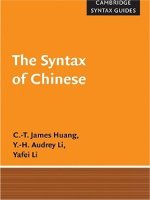UEfAP syntax
Bạn đang xem bản rút gọn của tài liệu. Xem và tải ngay bản đầy đủ của tài liệu tại đây (95.4 KB, 1 trang )
25/2/2016
UEfAP Syntax
UEfAP Syntax
Introduction
Syntax is a traditional term for the study of the rules governing the way words are combined to form
groups, clauses and sentences in a language. In contrasts with morphology, which studies the
structure of words.
The main syntactic elements of clauses are: Subject, Predicator, Complement (Direct Object, Indirect
Object, Subject Complement, Object Complement) and Adjunct.
Clauses are made up of groups, which are made up of words. Words combine to form groups.
Therefore, a group consists of one or more words; it can be thought of as an expanded word. A typical
structure of a group would be mhq modifier, head, qualifier. Groups combine to form clauses. Typical
groups are nominal groups, verbal groups, adjectival groups, adverbial groups.
Syntax studies the rules of these combinations.
For example, in a sentence such as:
Neural connections between the suprachiasmatic nuclei (SCN) and most other regions of the brain
have been cut and yet the SCN has continued to be rhythmic.
we may be interested in how the words combine to form a meaningful sentence. This is syntax.
However we might also be interested in how the words "connections, continued, rhythmic" can be
divided into parts: "connect + ion + s", "continued + d" and "rhythm + ic", or how "suprachiasmatic" is
formed. This is morphology.
Exercises
Try these exercises: Syntax Exercises
/>
1/1









